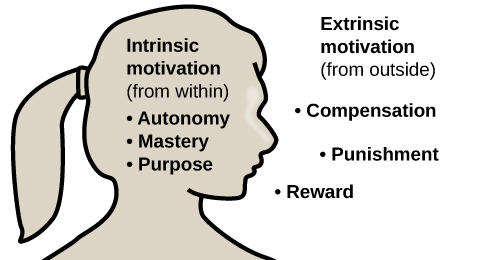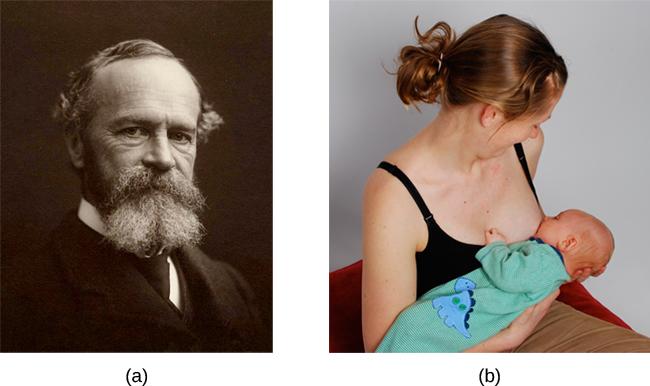6.3 Motivation
Learning Objectives
By the end of this section, you will be able to:
- Distinguish goals and motivation.
- Define intrinsic and extrinsic motivation & describe their impact on performance.
- Understand that instincts, drive reduction, self-efficacy, and social motives have all been proposed as theories of motivation.
- Describe predictors and consequences of goal commitment.
- Describe the factors that influence goal pursuit (implementation vs deliberative mindset, promotion vs prevention focus).
Motivation
Every New Year, many people make resolutions—or goals—that go unsatisfied: eat healthier; pay better attention in class; spend more time with loved ones. As much as we know our lives would improve if we actually achieved these goals, people quite often don’t follow through. But what if that didn’t have to be the case? What if every time we made a goal, we actually accomplished it? Each day, our behavior is the result of countless goals—maybe not goals in the way we think of them, like getting that beach body or being the first person to land on Mars. But even with “mundane” goals, like getting food from the grocery store, or showing up to work on time, we are often enacting the same psychological processes involved with achieving loftier dreams. To understand how we can better attain our goals, let’s begin with defining what a goal is and what underlies it, psychologically.
A goal is the cognitive representation of a desired state, or, in other words, our mental idea of how we’d like things to turn out (Fishbach & Ferguson 2007; Kruglanski, 1996). This desired end state of a goal can be clearly defined (e.g., stepping on the surface of Mars), or it can be more abstract and represent a state that is never fully completed (e.g., eating healthy). Underlying all of these goals, though, is motivation, or the psychological driving force that enables action in the pursuit of that goal (Lewin, 1935) that was discussed earlier in this. This reading will begin by covering theories of motivation and then move to describing research on goals.
Intrinsic and Extrinsic Motivation
Why do we do the things we do? What motivations underlie our behaviors? Motivation describes the wants or needs that direct behavior toward a goal. In addition to biological motives, motivations can be intrinsic (arising from internal factors) or extrinsic (arising from external factors) (Figure 10.2). Intrinsically motivated behaviors are performed because of the sense of personal satisfaction that they bring, while extrinsically motivated behaviors are performed in order to receive something from others.

Think about why you are currently in college. Are you here because you enjoy learning and want to pursue an education to make yourself a more well-rounded individual? If so, then you are intrinsically motivated. However, if you are here because you want to get a college degree to make yourself more marketable for a high-paying career or to satisfy the demands of your parents, then your motivation is more extrinsic in nature. Research has shown that intrinsically motivation (compared to extrinsic motivation) is associated with better conceptual learning, higher creativity, more cognitive flexibility, greater persistence, and enhanced well-being (Deci and Ryan 1985, Utman 1997).
In reality, our motivations are often a mix of both intrinsic and extrinsic factors, but the nature of the mix of these factors might change over time (often in ways that seem counter-intuitive). There is an old adage: “Choose a job that you love, and you will never have to work a day in your life,” meaning that if you enjoy your occupation, work doesn’t seem like . . . well, work. Some research suggests that this isn’t necessarily the case (Daniel & Esser, 1980; Deci, 1972; Deci, Koestner, & Ryan, 1999). According to this research, receiving some sort of extrinsic reinforcement (i.e., getting paid) for engaging in behaviors that we enjoy leads to those behaviors being thought of as work no longer providing that same enjoyment. As a result, we might spend less time engaging in these reclassified behaviors in the absence of any extrinsic reinforcement. For example, Odessa loves baking, so in her free time, she bakes for fun. Oftentimes, after stocking shelves at her grocery store job, she often whips up pastries in the evenings because she enjoys baking. When a coworker in the store’s bakery department leaves his job, Odessa applies for his position and gets transferred to the bakery department. Although she enjoys what she does in her new job, after a few months, she no longer has much desire to concoct tasty treats in her free time. Baking has become work in a way that changes her motivation to do it (Figure 10.3). What Odessa has experienced is called the overjustification effect—intrinsic motivation is diminished when extrinsic motivation is given. This can lead to extinguishing the intrinsic motivation and creating a dependence on extrinsic rewards for continued performance (Deci et al., 1999).

Other studies suggest that intrinsic motivation may not be so vulnerable to the effects of extrinsic reinforcements, and in fact, reinforcements such as verbal praise might actually increase intrinsic motivation (Arnold, 1976; Cameron & Pierce, 1994). In that case, Odessa’s motivation to bake in her free time might remain high if, for example, customers regularly compliment her baking or cake decorating skills.
These apparent discrepancies in the researchers’ findings may be understood by considering several factors. For one, physical reinforcement (such as money) and verbal reinforcement (such as praise) may affect an individual in very different ways. In fact, tangible rewards (i.e., money) tend to have more negative effects on intrinsic motivation than do intangible rewards (i.e., praise). Furthermore, the expectation of the extrinsic motivator by an individual is crucial: If the person expects to receive an extrinsic reward, then intrinsic motivation for the task tends to be reduced. If, however, there is no such expectation, and the extrinsic motivation is presented as a surprise, then intrinsic motivation for the task tends to persist (Deci et al., 1999).
In addition, culture may influence motivation. For example, in collectivistic cultures, it is common to do things for your family members because the emphasis is on the group and what is best for the entire group, rather than what is best for any one individual (Nisbett, Peng, Choi, & Norenzayan, 2001). This focus on others provides a broader perspective that takes into account both situational and cultural influences on behavior; thus, a more nuanced explanation of the causes of others’ behavior becomes more likely. (You will learn more about collectivistic and individualistic cultures when you learn about social psychology.)
In educational settings, students are more likely to experience intrinsic motivation to learn when they feel a sense of belonging and respect in the classroom. This internalization can be enhanced if the evaluative aspects of the classroom are de-emphasized and if students feel that they exercise some control over the learning environment. Furthermore, providing students with activities that are challenging, yet doable, along with a rationale for engaging in various learning activities can enhance intrinsic motivation for those tasks (Niemiec & Ryan, 2009). Consider Hakim, a first-year law student with two courses this semester: Family Law and Criminal Law. The Family Law professor has a rather intimidating classroom: He likes to put students on the spot with tough questions, which often leaves students feeling belittled or embarrassed. Grades are based exclusively on quizzes and exams, and the instructor posts results of each test on the classroom door. In contrast, the Criminal Law professor facilitates classroom discussions and respectful debates in small groups. The majority of the course grade is not exam-based, but centers on a student-designed research project on a crime issue of the student’s choice. Research suggests that Hakim will be less intrinsically motivated in his Family Law course, where students are intimidated in the classroom setting, and there is an emphasis on teacher-driven evaluations. Hakim is likely to experience a higher level of intrinsic motivation in his Criminal Law course, where the class setting encourages inclusive collaboration and a respect for ideas, and where students have more influence over their learning activities.
Theories About Motivation
William James (1842–1910) was an important contributor to early research into motivation, and he is often referred to as the father of psychology in the United States. James theorized that behavior was driven by a number of instincts, which aid survival (Figure 10.4). From a biological perspective, an instinct is a species-specific pattern of behavior that is not learned. There was, however, considerable controversy among James and his contemporaries over the exact definition of instinct. James proposed several dozen special human instincts, but many of his contemporaries had their own lists that differed. A mother’s protection of her baby, the urge to lick sugar, and hunting prey were among the human behaviors proposed as true instincts during James’s era. This view—that human behavior is driven by instincts—received a fair amount of criticism because of the undeniable role of learning in shaping all sorts of human behavior. In fact, as early as the 1900s, some instinctive behaviors were experimentally demonstrated to result from associative learning (Faris, 1921).

Another early theory of motivation proposed that the maintenance of homeostasis is particularly important in directing behavior. You may recall from your earlier reading that homeostasis is the tendency to maintain a balance, or optimal level, within a biological system. In a body system, a control center (which is often part of the brain) receives input from receptors (which are often complexes of neurons). The control center directs effectors (which may be other neurons) to correct any imbalance detected by the control center.
According to the drive theory of motivation, deviations from homeostasis create physiological needs. These needs result in psychological drive states that direct behavior to meet the need and, ultimately, bring the system back to homeostasis. For example, if it’s been a while since you ate, your blood sugar levels will drop below normal. This low blood sugar will induce a physiological need and a corresponding drive state (i.e., hunger) that will direct you to seek out and consume food (Figure 10.5). Eating will eliminate the hunger, and, ultimately, your blood sugar levels will return to normal. Interestingly, drive theory also emphasizes the role that habits play in the type of behavioral response in which we engage. A habit is a pattern of behavior in which we regularly engage. Once we have engaged in a behavior that successfully reduces a drive, we are more likely to engage in that behavior whenever faced with that drive in the future (Graham & Weiner, 1996).

Self-efficacy and Social Motives
Self-efficacy is an individual’s belief in her own capability to complete a task, which may include a previous successful completion of the exact task or a similar task. Albert Bandura (1994) theorized that an individual’s sense of self-efficacy plays a pivotal role in motivating behavior. Bandura argues that motivation derives from expectations that we have about the consequences of our behaviors, and ultimately, it is the appreciation of our capacity to engage in a given behavior that will determine what we do and the future goals that we set for ourselves. For example, if you have a sincere belief in your ability to achieve at the highest level, you are more likely to take on challenging tasks and to not let setbacks dissuade you from seeing the task through to the end.
A number of theorists have focused their research on understanding social motives (McAdams & Constantian, 1983; McClelland & Liberman, 1949; Murray et al., 1938). Among the motives they describe are needs for achievement, affiliation, and intimacy. It is the need for achievement that drives accomplishment and performance. The need for affiliation encourages positive interactions with others, and the need for intimacy causes us to seek deep, meaningful relationships. Henry Murray et al. (1938) categorized these needs into domains. For example, the need for achievement and recognition falls under the domain of ambition. Dominance and aggression were recognized as needs under the domain of human power, and play was a recognized need in the domain of interpersonal affection.
Goals
In this section, we discuss the origins and manifestation of goals and review factors that influence individuals’ motivation in the course of pursuing a goal.
Goal Adoption
What makes us commit to a goal? Researchers tend to agree that commitment stems from the sense that a goal is both valuable and attainable, and that we adopt goals that are highly likely to bring positive outcomes (i.e., one’s commitment = the value of the goal × the expectancy it will be achieved) (Fishbein & Ajzen, 1974; Liberman & Förster, 2008). This process of committing to a goal can occur without much conscious deliberation. For example, people infer value and attainability, and will nonconsciously determine their commitment based on those factors, as well as the outcomes of past goals. Indeed, people often learn about themselves the same way they learn about other people—by observing their behaviors (in this case, their own) and drawing inferences about their preferences. For example, after taking a kickboxing class, you might infer from your efforts that you are indeed committed to staying physically fit (Fishbach, Zhang, & Koo, 2009).
Consequences of Goal Activation
 What does this image represent to you, a number or a letter? Training to run the Boston Marathon? Need to pass 13 credit hours to graduate this semester? The details of your goals may influence how you interpret the world around you. [Image: Leo Reynolds, https://goo.gl/TXhu3C, CC BY-NC-SA 2.0, https://goo.gl/Toc0ZF]
What does this image represent to you, a number or a letter? Training to run the Boston Marathon? Need to pass 13 credit hours to graduate this semester? The details of your goals may influence how you interpret the world around you. [Image: Leo Reynolds, https://goo.gl/TXhu3C, CC BY-NC-SA 2.0, https://goo.gl/Toc0ZF]
The activation of a goal and the accompanying increase in motivation can influence many aspects of behavior and judgment, including how people perceive, evaluate, and feel about the world around them. Indeed, motivational states can even alter something as fundamental as visual perception. For example, Balcetis and Dunning (2006) showed participants an ambiguous figure (e.g., “I3”) and asked them whether they saw the letter B or the number 13. The researchers found that when participants had the goal of seeing a letter (e.g., because seeing a number required the participants to drink a gross tasting juice), they in fact saw a B. It wasn’t that the participants were simply lying, either; their goal literally changed how they perceived the world!
Goals can also exert a strong influence on how people evaluate the objects (and people) around them. When pursuing a goal such as quenching one’s thirst, people evaluate goal-relevant objects (e.g., a glass) more positively than objects that are not relevant to the goal (e.g., a pencil). Furthermore, those with the goal of quenching their thirst rate the glass more positively than people who are not pursuing the goal (Ferguson & Bargh, 2004).
Self-Regulation in Goal Pursuit
Many of the behaviors we like to engage in are inconsistent with achieving our goals. For example, you may want to be physically fit, but you may also really like German chocolate cake. Self-regulation refers to the process through which individuals alter their perceptions, feelings, and actions in the pursuit of a goal. For example, filling up on fruits at a dessert party is one way someone might alter his or her actions to help with goal attainment. In the following section, we review the main theories and findings on self-regulation.

